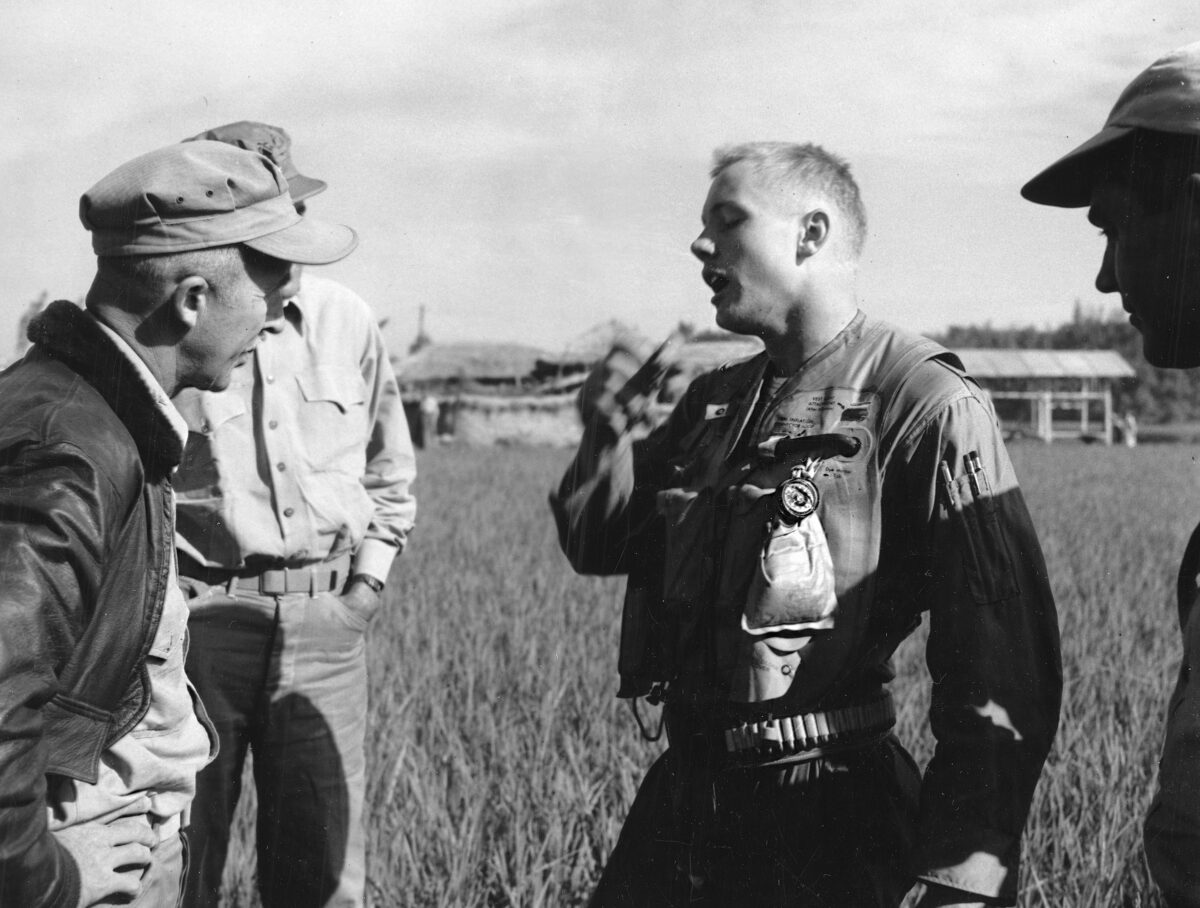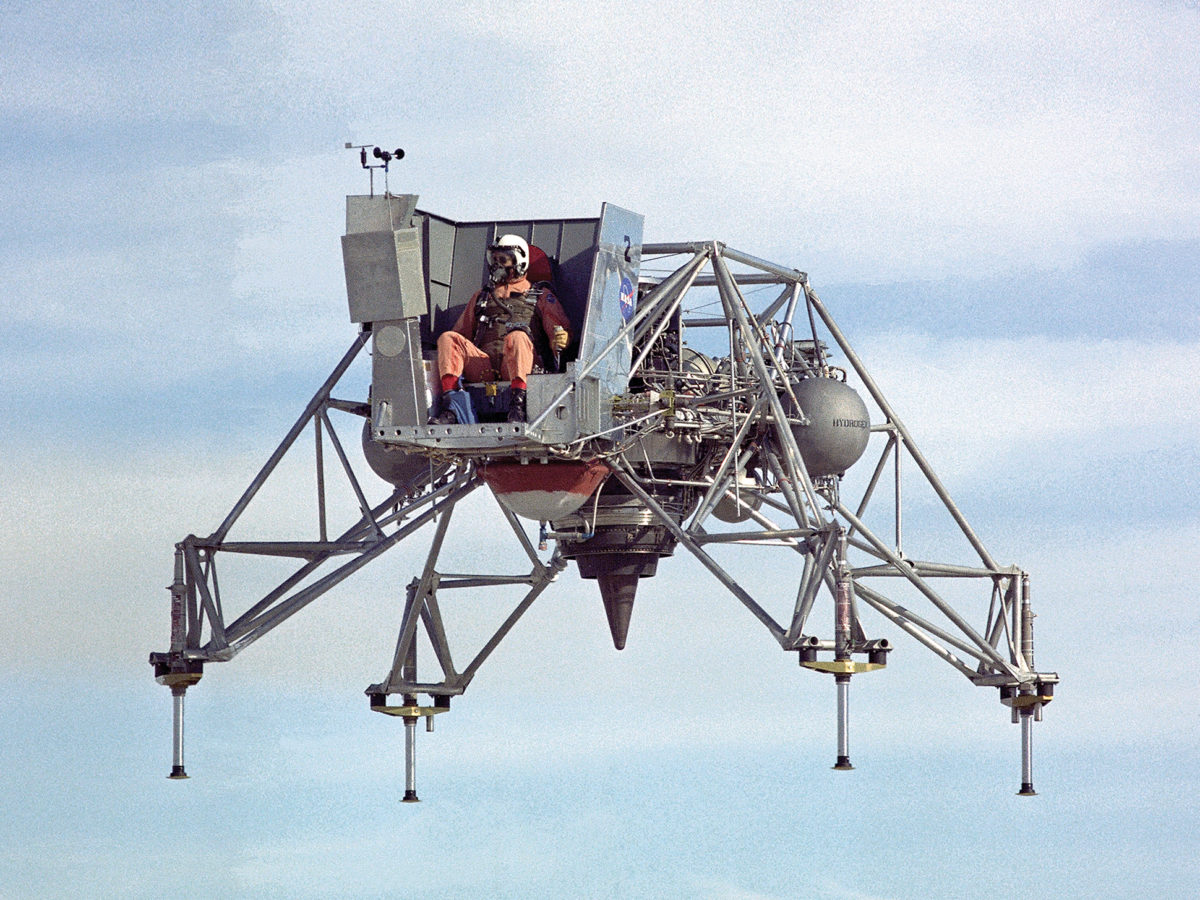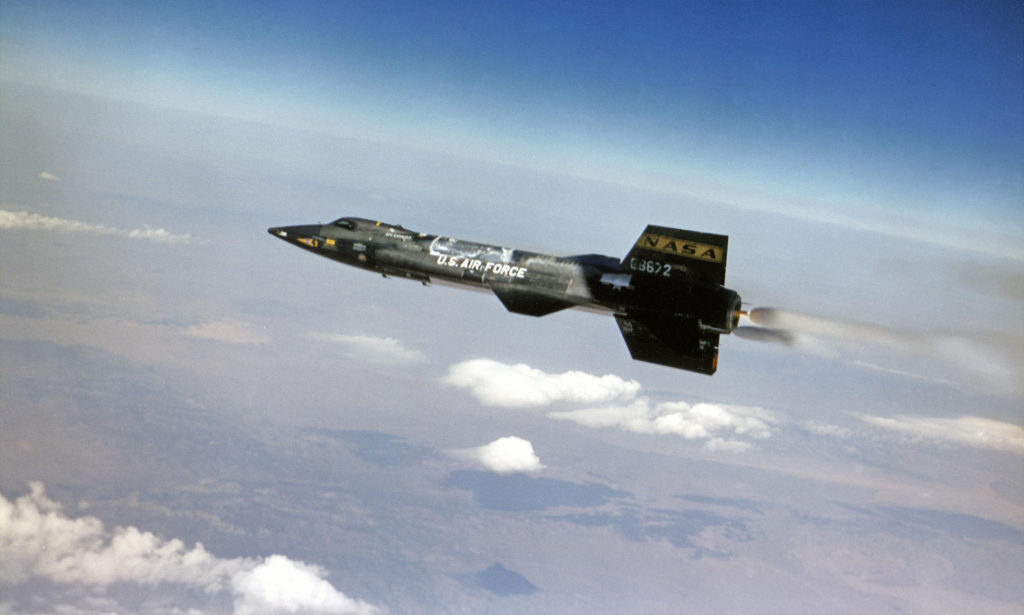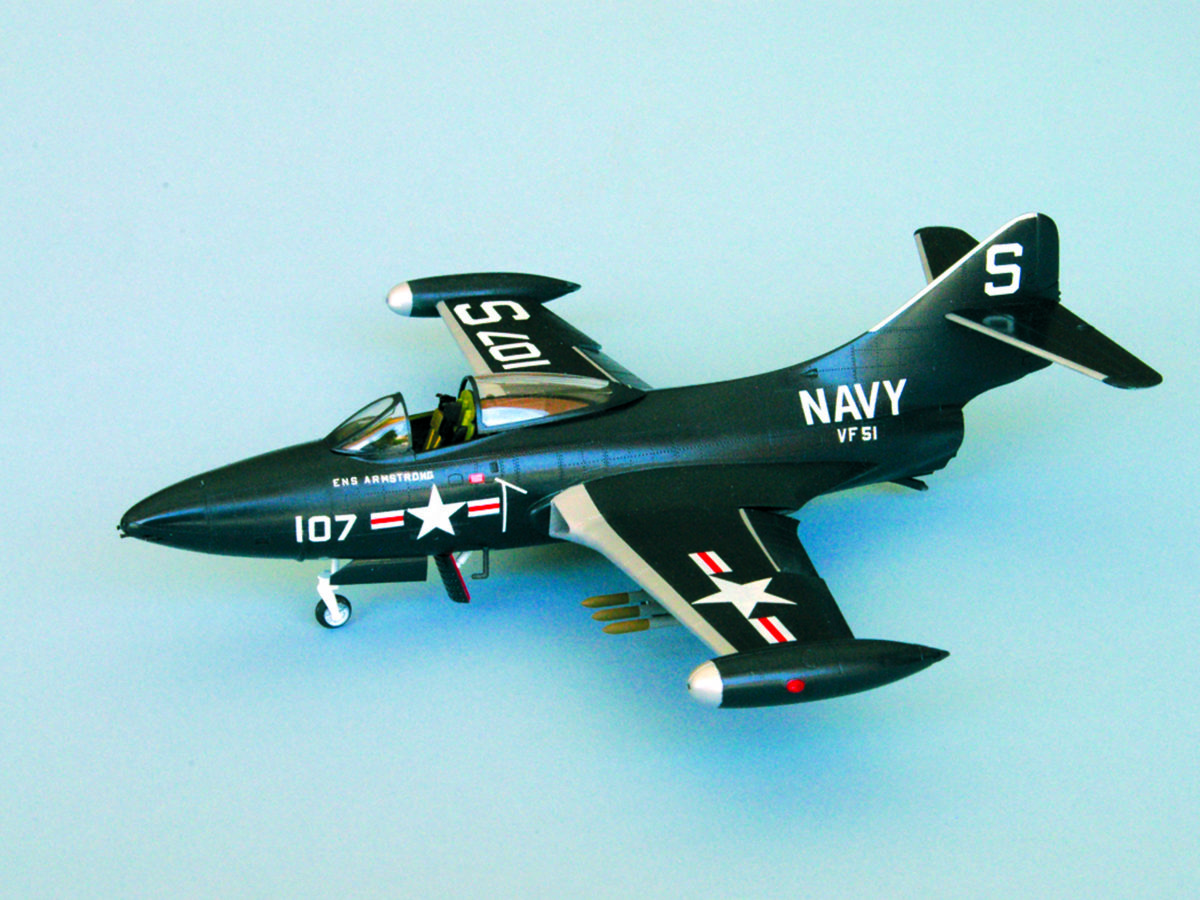Neil Armstrong’s flying career nearly ended soon after it started, when he was forced to eject from his F9F Panther over Korea.
At daybreak, pilots came onto the deck of the aircraft carrier USS Essex. Bundled like schoolchildren on a snow day, they waddled to their jet fighters. One of the first to climb aboard was a young ensign named Neil Armstrong.
His plane’s captain helped Neil into the cockpit—helped him connect his shoulder and lap straps, double-checked his parachute harness and rechecked his oxygen mask. Last, he made sure Neil’s life raft and radio were ready to go.
Suddenly, flight deck speakers blared, “Prepare to launch aircraft!”
The date was September 3, 1951.
Armstrong had turned 21 only four weeks earlier, but now he was suited and ready to fly his seventh combat mission.
“Move jet into position for launching!”
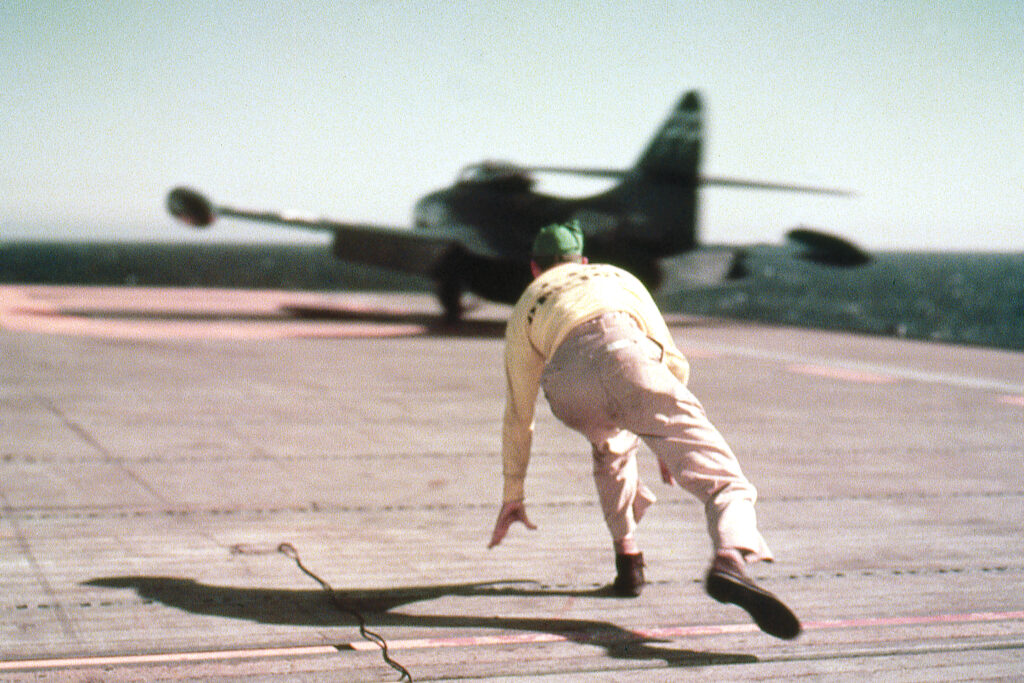
The deck crew inched his Panther onto its catapult, and Neil reminded himself that his first few “hot catapult” launches had taken faith. There was a degree of uncertainty. If for one reason or another the catapult produced a weak shot, he and his Panther could end up in the water. He instinctively rechecked his harnesses and lap belt before resting a gloved hand on the jet’s control stick. His other hand rested on the throttle. He was ready to increase his Panther’s power plant to maximum thrust.
“Launch jet!”
Neil felt himself go rigid. He saw the launch officer whirl one finger above his head and he increased his jet’s thrust to an unbearable roar and waited—waited until the launch officer whirled two fingers, then moved instantly to maximum thrust.
The white heat scorched everything nearby, and the launch officer’s right hand shot downward. The catapult fired.
Neil felt his weight double. His facial skin stretched from the powerful acceleration. His lips lengthened. His body slammed against his seat. Eight tons of jet and pilot were swept down the catapult track, and within one blink of his eyes—less than the length of a football field—Neil’s Panther climbed from its carrier’s deck. Acceleration held him prisoner as one jet fighter and its pilot reached for sky.
Minutes would pass before Neil Armstrong would fly high enough and fast enough to become part of the soul-lifting beauty of quiet flight. It was the perfect escape—streaking ahead so fast that the overwhelming whine of his jet never caught up. It was necessary to capture the moment—to enjoy the single last morsel of time wherein a fighter pilot could relax before sending his 500-pounders under his wings and his 20mm shells from his guns speeding toward their targets.
Neil was aware it was his final moment of sanctuary from those who would be trying to do him harm, and despite his age his older brethren of the air regarded him as a competent flier. He taught himself to focus on the reasonable and the plausible instead of imagined fears.
Neil would never lose sight of the fact he was a small-town boy with 15 cents in his pocket. He was thankful he was flying jets for the Navy, thankful he had the get-up-and-go to study what made the machines he flew fly, and the good sense to hit the books until he roped himself acceptance into the Navy’s aviation midshipman program.
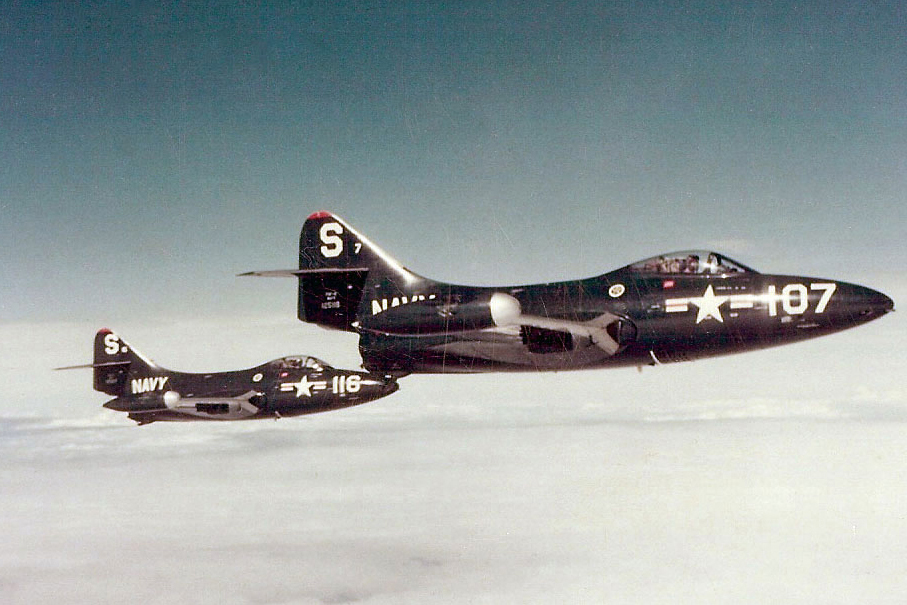
He had selected Purdue University. The Navy’s seven-year program called for him to spend two years in the classroom studying aeronautical engineering. Then there would be flight training, where he’d get his commission as a Navy ensign followed by active duty before completing classes for his degree.
But it didn’t work out that way. After he had studied for a year and a half the Navy discovered they were short on fighter pilots, and Neil was called early to flight training.
He got his wings in August 1950, two months after the Korean War had begun. Neil was one of those rare birds, a midshipman with wings. He had to wait a few weeks for his ensign bar.
Armstrong the Aviator
“I asked for the Pacific Fleet and was given the Pacific Fleet,” he would later say. “I was first sent out to a squadron called FASRON, Fleet Air Service Squadron, which was a utility unit where I waited until there was an opening in Fighter Squadron 51 [VF-51]. I’d be flying from the deck of the Essex with midshipman wages of 75 dollars a month plus flight pay calculated at 50 percent of my base wage.”
Neil had no regrets as the morning flight continued, suddenly feeling himself enjoying the new day. The sun was peaking over the horizon, spreading its warming rays. He studied the sky filled with VF-51 pilots and their planes. It was a togetherness that brought with it a certain sense of safety.
Better than being alone, Neil agreed with himself, as he suddenly saw one of nature’s stunning creations, Mount Fuji in the rising sun.
The magnificent volcano’s cone was perfect, rising 12,000 feet to poke a hole through the clouds. Just as suddenly as Japan’s most recognized landmark appeared, Neil was aware the peace the great mountain brought with it was about to end.
Dead ahead, across the Sea of Japan, were the mountains of Korea—ugly mountains placed there by some ancient geological event that tortured them into jagged boldness, left them twisted and scattered, presenting no organized or logical face to visitors.
Neil judged them as terrible mountains—mountains of pain and death that ran in crazy directions. Their peaks formed no patterns. Their valleys led nowhere yet somewhere. Hidden from his view were today’s targets.
His group’s assigned duty was to fly into a hot zone naval intelligence called “Green Six.” It was the code name for a valley with gun sites, freight yards and trains, a dam and one of those ever-loving stubborn bridges.
Neil was comfortable flying the F9F Panther. He thought of it as a very solid airplane—built by the Grumman team, the best airplane builders around. “But in retrospect,” he said, “it didn’t fly well. It didn’t have particularly good handling qualities. Pretty good lateral directional control, but very stiff in pitch. Its performance both in max speed and climb were inferior to the MiG-15 by a substantial amount.
“I’m sure I would not have enjoyed going against a MiG in my Panther,” he laughed.
They crossed the Korean coastline. The guns were waiting. Essex’s fighters began to descend in swift dips and dives to confuse the anti-aircraft. Then John Carpenter, Neil’s group leader, pounced his Panthers upon the heaviest guns with blazing fire, raking the big gun emplacements through gray smoke and bursts of flak as they thundered straight down Green Six—lower and lower they charged, releasing their 500-pound bombs as 5-inch and 3-inch guns, even machine guns, fired at their jets.
Neil was instantly aware that a single shell could pulverize any of them. When he climbed up from the valley, heaviness was upon his legs and his face was drawn down on his chin. The gravity gods were at work as he kept his Panther snug on Carpenter’s wing.
Back upstairs Neil could see clearly the targets were essentially demolished with one exception—that damn bridge.
John Carpenter saw it, too, and their leader immediately recognized the job needed to be finished.
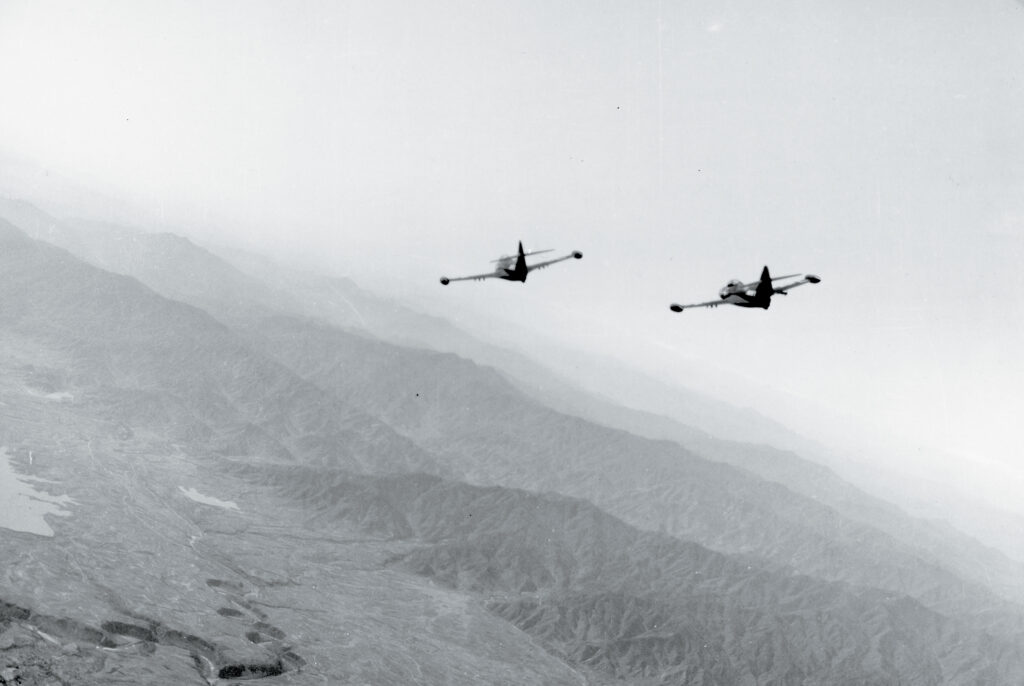
Carpenter rolled his Panther left and brought his group down again, jets screaming along the shimmering river. They were roaring toward the bridge like bats out of Hades, thundering straight for the stone and steel spanning the river. Neil quickly noticed its historic appearance—tall pillars rising above one of North Korea’s major waterways, and decidedly vulnerable. He activated his nose guns and watched his heavy bullets rip into concrete and stone before releasing his last 500-pound bomb, which exploded, tearing and twisting the bridge into useless steel.
Time to reach for sky again, Neil ordered himself. He hauled back on the Panther’s stick. Damn! He had only a brief instant to see an anti-aircraft cable stretching hundreds of feet from mountain to mountain.
WHOMP!!!
An ugly shockwave shook his fighter from nose to tail.
“If you’re going fast, a cable will make a very good knife,” Neil told me later, remembering how the tightly wrapped strands of steel had sliced through his right wing too swiftly to be seen. It cut metal, wiring, tubing and his control connections. Instantly 6 to 8 feet of his wingtip was no longer there.
Quickly Neil judged he was about 500 feet from the ground; his speed was 350 knots. His damaged Panther was flying at an angle that could aerodynamically compensate for the loss of almost half of his right wing—as long as he held the undamaged aileron on his opposite wing at full deflection.
Neil had to make rapid judgments. Not only had he lost almost half of his right wing and much of its aileron, his elevators had become sluggish.
“Damn!” Neil spat. The ground was coming up, coming up fast, and he had to—Oh, trim! With lagging elevators, trim tabs would boost them so he could climb. As quickly as his thumb could move the “coolie hat” trim toggle atop his control stick he was rolling in trim to bring his jet’s nose up. But nothing was happening! Wait, there it goes! His nose was rising. “Move, move,” he shouted at the forward end of his Panther. And it did, just before he would have clobbered Korean dirt. He was headed back upstairs—a slow, steady climb—and he was instantly aware he was not breathing. He gulped in air. “Armstrong,” he shouted aloud. “Twenty feet above ground is no place to be at 350 knots.”
If Neil had had time to sweat he would have. Instead, the young fighter pilot radioed John Carpenter. “Hey, boss,” he stammered. “I’ve lost…I’ve lost about half of my starboard wing. I’m carrying a lot of aileron to keep from rolling, and if I get too slow she’s gonna roll on me.”
“Roger.”
“I’m regaining altitude slowly,” Neil told Carpenter. “I have all the trim back on its heels, and my elevators aren’t much use. I’ll have to make one hot landing.”
“How hot?”
“About 170.”
“Too damn hot,” Carpenter shot back, realizing the carrier couldn’t handle 170.
“Yes, sir,” Neil agreed. “But she won’t fly any slower without rolling.”
“Understand.”
“Eject?”
“Eject,” said the group head quietly, “and I’ll stay with you all the way, Armstrong.”
The two fliers reflected on the decision they’d just made. Then Carpenter asked, “Think about 14,000 feet will do it?”
“Should,” Neil agreed. “Just want to make sure I’m high enough to have time to complete all those ejection procedures before I hit ground.”
“Good idea,” Carpenter laughed, adding, “The nearest friendly territory is down south. It’s Pohang Airfield, K-3.”
“The Marines?” Neil questioned.
“That’s the one.”
“That’ll be good,” Neil agreed, adding, “But no bailout over North Korea.”
“Yeah, not too many come back.”
“If I miss K-3,” Neil told him, “I’ve always liked water. It’s a softer landing.”
“Roger that,” Carpenter agreed as the side-by-side jets climbed from Green Six, located on a narrow valley road south of Majon-ni, west of Wonsan.
Neil wasn’t alone in his thinking. Both he and John Carpenter were aware they were planning what most pilots viewed as one of the most dangerous parts of their job—ejecting at jet speeds. That was the bad news. The good news was Neil had confidence in Carpenter’s judgment. He was an Air Force major, on an exchange with the Navy. He liked the challenges of flying off carriers, and Neil liked flying his wing—liked learning. But there was more—in his brief 21 years Neil had never really thought about bailing out or ejecting from a plane that could still fly. He had not trained to do such a thing. One of his classmates had gone over to parachute school in El Centro, Calif., for ejection training and had come back and told them how to do it.
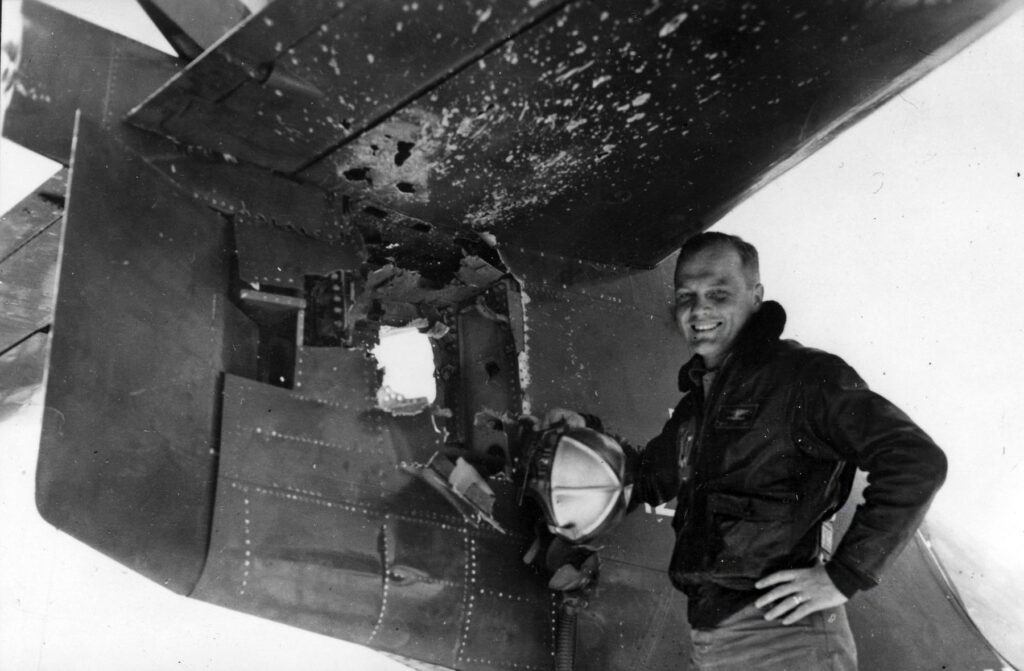
That was the extent of Neil’s schooling on ejecting, and he began thinking through what he was about to do as the two Panthers continued south. The farther they flew, the more the mountains of Korea showed beauty. Gone were the tortured profiles and the senseless chaos of the north. To their right reservoirs glistened like fine pearls holding the hills. To their left snow hung upon the ridgelines. Before them the waters of the Sea of Japan held their carrier. But the ship would not be there for Neil.
He would be ejecting, so he studied the hazards. He had a shotgun-shell-powered seat to blow him quickly away from his plane. He would instantly be clear of everything around him, but that instant speed would slam his body with such force he would suddenly weigh 22 times his own weight, or in pilot lingo 22Gs. Not a lot of tolerance for error! The likelihood of some kind of injury was high—injury to the shoulders, arms, legs and feet if he was not properly tucked in. He’d best be in the correct position or the ejection could cause him to create a new crater in Korean soil.
John Glenn, who flew combat missions in Korea as a Marine fighter pilot, tells the story of his famous wingman, baseball slugger Ted Williams. Williams suffered an engine flameout in his F9F Panther, and despite the possibility that his jet engine might explode, opted to fly to the nearest alternate landing field. He knew of a pilot who had ejected and suffered permanent injuries to his feet, and had vowed to never eject. He feared it would end his baseball career. Famed test pilot Chuck Yeager, who on October 14, 1947, became the first man to break the sound barrier, called ejecting from a speeding jet “committing suicide to avoid getting killed.”
Neil smiled. He’d heard it all. But when you are left with one choice, you’re happy to have it.
The science of the day on ejecting made it pretty clear that being shot out of a speeding jet could severely compress your vertebrae. This is why the Navy had put a lifetime limit on the total number of times one of its aviators could eject. Neil had no plans to test the limit. He reached for his ejection seat instructions and began reading carefully:
One: Reduce airspeed if possible. 250! Yep, that’s about as slow as I want to go.
Two: Check that safety belts and harnesses are locked.
Three: Pull pre-ejection lever inboard and push hard down until locked. This jettisons the canopy, dumps cabin pressure, lowers seat, releases knee braces and pulls safety pin in seat catapult firing mechanism.
Four: Pull your feet back and place them on their footrests.
Five: Sit erect, head back against the headrest with muscles tensed. Pull face curtain down until fully extended.
Six: After drogue chute opens and seat stabilizes, release the face curtain, cast off harness and roll forward out of the seat. If altitude permits, delay at least five seconds before pulling the ripcord.
Neil took a deep breath and read a final warning on the instructions. DO NOT PULL RIPCORD WHILE IN SEAT.
Damn good idea, Neil thought as he moved his eyes from the ejection procedures for a last look outside. His squadron had all come back before with bullet holes in their Panthers. They’d patched them up, covered them with fresh paint and they looked pretty good. This would be the first time he’d ejected, but with John Carpenter playing nurse on his wing, Neil’s confidence grew. He was ready. His calmness was inborn. During his adolescence, he’d had a recurring dream about flying. He would hover in the air and if he held his breath he would never fall.
Silently, across the sky the two jet fighters trekked south side by side. Neil was aware he and Carpenter had never been particularly friendly—their interests and ages varied. They never talked much, but now in the sky with sunlight gleaming on the mountains they seemed like best friends. In his earphones he heard Carpenter open his microphone.
“We’ll make it, Armstrong,” his lead said reassuringly.
“Yeah, no doubt,” Neil quickly agreed, impatient to end any conversation that might prevent his thoughts from focusing on the task ahead.
Carpenter sensed Neil’s unwillingness to break concentration. They moved ahead through the sunny spaces, nursing Neil’s crippled Panther over North Korean villages. From time to time they could see a burst from a gun, and then suddenly they were there, moving over Pohang Airfield with the sea in view. Carpenter told him, “Armstrong, make sure your shoulder straps and seat belts are tight.”
“They’re already choking me,” Neil replied.
“Good boy,” acknowledged Carpenter. “You ready to hit every item on your checklist?”
“Roger, I’m ready.”
“You holding 250?”
“Roger.”
“You’d better jettison that canopy right now.”
“Good idea.”
“See you back on ship,” Carpenter said, and Neil, with the loud snap of his canopy jettisoning and the blast of outside air whipping across his helmet, pushed as far back in his seat as he could. He firmly placed his feet on their footrests.
Muscles tight, he took a deep breath and shouted aloud his final checklist:
“Pre.” (All was in place.)
“Pos.” (He was in proper position.)
“Ox.” (He’d switched on his small green bottle of oxygen that would keep him breathing on his way to the ground.)
Neil was blessed with the ability to put off fear until the predicament he was in was over. He reached up, grabbed the face curtain that would protect his upper body, shouted “pull” and with one quick and firm jerk pulled the curtain over his helmet and face to the center of his chest.
WHAM!!!
Neil was blown out of his cockpit by a violent crack of thunder as he held the face curtain firmly over his helmet and eyes. The 22Gs made him feel as if all his body parts had been squeezed into a space the size of a breadbox, and he felt himself tumbling head over heels backward.
He was aware his seat and his body were rocketing upward. Adrenalin pounded through every muscle. The small drogue parachute popped out and stabilized Neil and his seat in the airflow. He felt the blast of wind and the noise leave, and he was most aware his tailbone was hurting from the ejection’s kick in the ass.
It was time to let the face curtain go. Now he could see sea and sky rapidly vanishing and quickly reappearing again, and he quickly caught his breath as he felt the Gs leaving his body…and he was suspended in midair…weightless…and he felt his seat become more stable. He literally ripped off his harness and rolled forward out of it—suddenly free with his ripcord in his grip. Despite his altitude he counted, “One Mississippi, two Mississippi, three Mississippi, four Mississippi, five Mississippi,” and pulled. The chute came streaming out gradually so as not to break his back. Then the best sight Neil had ever seen—a big day-glo orange and white main parachute blossoming above him. He felt safe, he felt well—he’d survived the high-speed ejection.
It was a great feeling to believe you were home free. Neil was happy to see his ride down was taking him back to land—back to Pohang Airfield, K-3, where U.S. Marines would have his back.
He floated earthward, swaying back and forth, and as he dropped lower, he could see a rice paddy below. He opened his helmet’s faceplate and quickly disconnected all hoses and snaps. Then he removed his helmet, dropping it to earth. Neil wanted nothing impeding his hasty exit from his chute just in case there were unfriendlies around.
He braced himself for…
Into the rice paddy he went with a good pop. Certainly not as bad as the kick he had just received ejecting from his Panther. He freed himself from the chute and began running for cover.
He had taken only a few steps when he saw his helmet and its straps. He stopped and picked them up, noticing his helmet was cracked from its fall.
He stood erect, surprised to see an American jeep racing toward him.
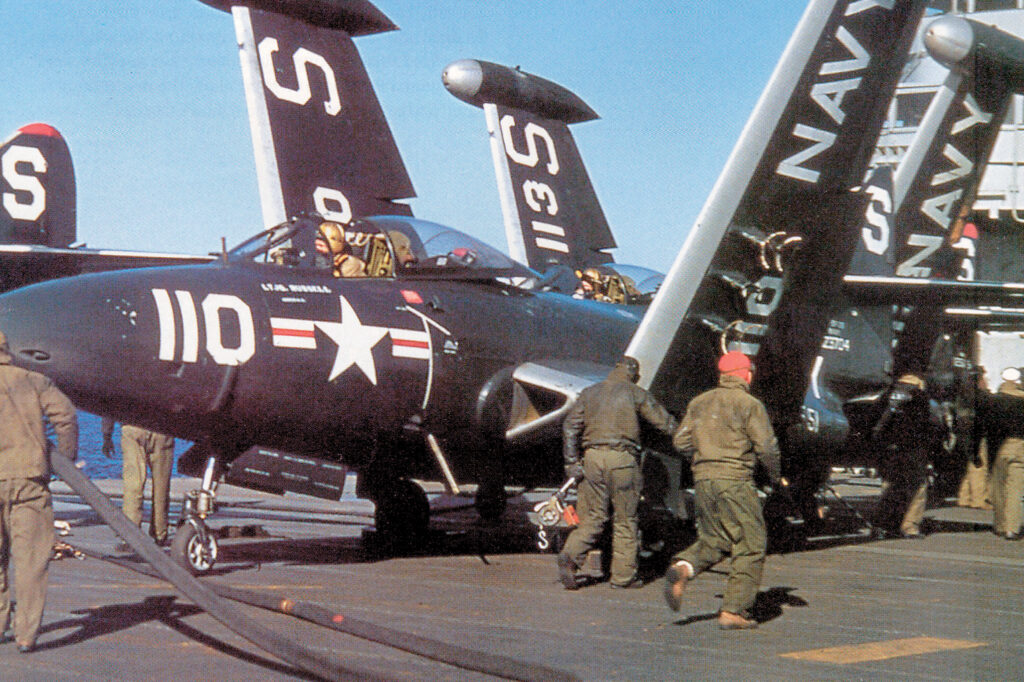
There was no doubt he had landed on the Marines’ K-3 base—driving the jeep was a face he knew. His smile was suddenly wider than half of Texas. It was one of his roommates from flight school, Goodell Warren. Warren was now a Marine lieutenant operating out of Pohang, and he yelled, “Armstrong, what the hell are you doing in my rice paddy?”
“Goodie,” he called smiling from ear to ear. “You never looked so good.”
The two midshipman buddies grabbed each other, and Goodell Warren told him the explosions they were hearing out at sea came from the mines in the bay the North Koreans were laying.
Neil suddenly realized if his parachute had not drifted back to land, he might now be afloat in those deadly waters.
But all was well. Lieutenant Warren took care of his friend Neil, taking him to the brass for immediate debriefing.
Neil would only spend one night with Goodell and the Marines before being sent back to duty aboard Essex. There he was greeted with some good-natured ribbing. One of his fellow pilots was John Moore, who would in years to come be elected mayor of Cocoa Beach, Fla., the hometown of the launch site that would send Neil to the moon. Moore insisted that Armstrong pay for the Navy property he’d destroyed, including the helmet he’d cracked.
Neil had a good laugh, not in the least aware that the gods of providence were saving him for history.
During the course of his 55-year career with NBC News, Jay Barbree was the only reporter to have covered all 166 American astronaut flights and moon landings. He received an Emmy for his coverage of Neil Armstrong’s first moonwalk. This article is excerpted from Barbree’s new book, Neil Armstrong: A Life of Flight. Copyright ©2014 by the author and reprinted by permission of Thomas Dunne Books, an imprint of St. Martin’s Press, LLC.

